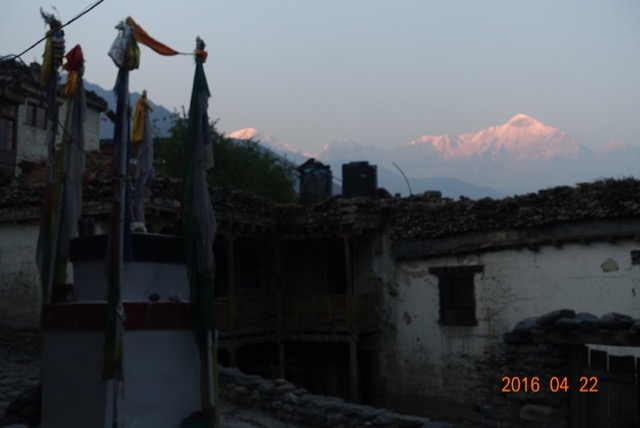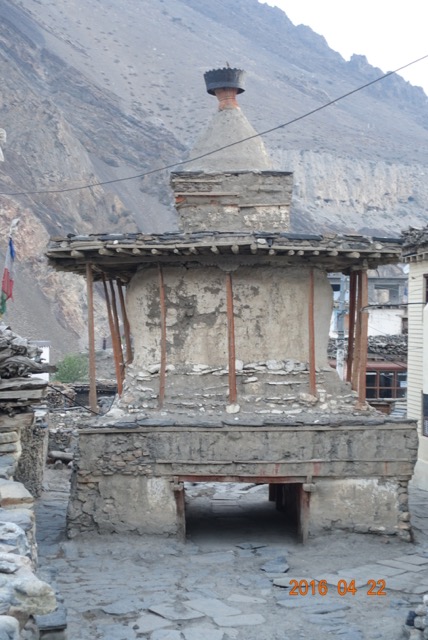The bells seemed distant at first – a faint metallic rattle filtering through the drafty window of our second story room. Just as the planes and airports had been growing progressively smaller and more primitive as we moved out from the cacophonous chaos of Kathmandu into the desolate plateau beyond the Himalayan crest, so too the accommodations. Hotel Tibet in the capital: wood paneled, luscious breakfast buffet; Pokhara lodging: spacious enough, but electricity only in the evening. Now in Kagbeni, not yet a tea house, but barely a hostel. We did have a bathroom of our own, but the toilet was attached to the wall by precarious plastic clips, the shower centered between the sink and commode, uncurtained and splashing water on both. The hot water just a promise. Wooden floors lay below a threshold of exposed frame with a raised step-over, easy to trip across. The single pane glass windows had merely the suggestion of a curtain.
But the bells brought me up quickly. I looked outside just as the lead goats curved first right, then left just beneath the window. I pulled my camera from my pack, switched on video, and watched as the entire town’s entire population of nannies, bucks and kids waddled purposely up the stone passageway, heading out to the day’s pasture. Guided by several townsmen, they appeared to know the way. But it certainly wasn’t something I’d ever seen before, even in rural Colorado or Washington.
Seeing them gave me impetus to go out and explore the town. The sun was just coming up over the eastern ridge, highlighting sharp white peaks to our south. Beneath rock slabs which covered the narrow streets, water flowed in channels from the western snowfields into barley fields below, just now sprouting green shoots drifting in the morning stillness. Come afternoon, they would be a waving verdant sea, bending ever north with the incessant afternoon gales.
To my right out of the lodge stood a half-buried chorten. These monuments guard the entrance and exit of every town in Mustang. Bas reliefs depicting key moments in the life of the Buddha sometimes decorate the sides. The centers are arched pass-throughs, like a tunnel tree in the redwoods. Above, the bulbous tops are hollow. Relics are hidden in the onion shaped roof, remains of Buddhist monks or nuns, or maybe scripture fragments. In major cities and holy sites, they are called “stupa”, grand in stature and focal points for pilgrims.
On the lonely steppe in Mustang, these seem less linked to religion, and more as a “city limits” sign. This one in Kagbeni was half-buried, gradually being swallowed from below as the town grew and re-paved its paths. Just now, an older women in black thick wool dress, with bright multi-colored apron around her waist, was sweeping up after the goat’s passage. She’d throw a bowl full of water on the stony road, and make a stab at pushing the droppings to the side of the road. But she seemed more concerned about moving the dust around than actual public sanitation.
The evening before, we had gone exploring. Kagbeni is a hub for tourists, trekkers, and pilgrims. To the east, Indian Hindus head for Muktinath, a 7 mile walk or jeep ride away, with 3200’ of elevation gain. There, a site holy to both Hindi and Buddhist draws hundreds daily. We will visit there on the final day of our adventure. Also, this route is part of the famed Annapurna Circuit, a trekking classic mainly traversed by the young, as it can be managed without a guide. To the west lies Dolpo, another of Nepal’s many hidden valleys. Like Mustang, it contains remnants of Tibetan culture, with the locals practicing Bon, a precursor root to Tibetan Buddhism. And to the north, Mustang, where we are headed.
We push towards the northern perimeter, where we find a large squat red cube-shaped building; a monastery for sure, as they are are always plastered with this distinctive pigment. Below sits a mani-wall. Like the chorten, these appear along the main routes in and out of towns, as well as near monasteries. Long, stucco’ed slabs of rocks, with a covered alcove along the top. Within that space, monks insert a series of darkly stained cylinders, each a bit larger than a coffee tin, covered with writing which must be prayers. Inside, there is rolled up scroll, again filled with hand-written prayers. Suspended by a pole through the center, with stout wooden spokes sticking out from the bottom, they are meant to be spun while walking by, allowing the prayers within and without to be sent off into the wind, up to the sky and out to all the world. One must always pass to the left, spinning with the right hand. Much easier then going to church, or even praying five times a day on a mat, I think.
At the northern edge of town, we are stopped by a stern notice, hand written in English and posted outside the police booth, warning us that travel beyond is restricted to the north. This provides a chilling sense of apprehension for our walk through there tomorrow. We head back, and wander down to the river. Here at Kagbeni, the Kali Gandaki chutes through a narrow gap as it drops precipitously, almost a waterfall. The steep cliffs act as a funnel neck to the warm air being pushed up from the south. There is a steel suspension bridge over the gorge. In the middle, the wind nearly blows us up and over the slender supporting cable. Below, Indian ladies in saris with rolled up hems are stepping in the waters. Apparently, this is another holy site, and the ritual baptismal immersion is required of all pilgrims on their way to Muktinath. On the way back, they pause at tables where grizzled men offer saligrams for sale.




1 Response to Kagbeni